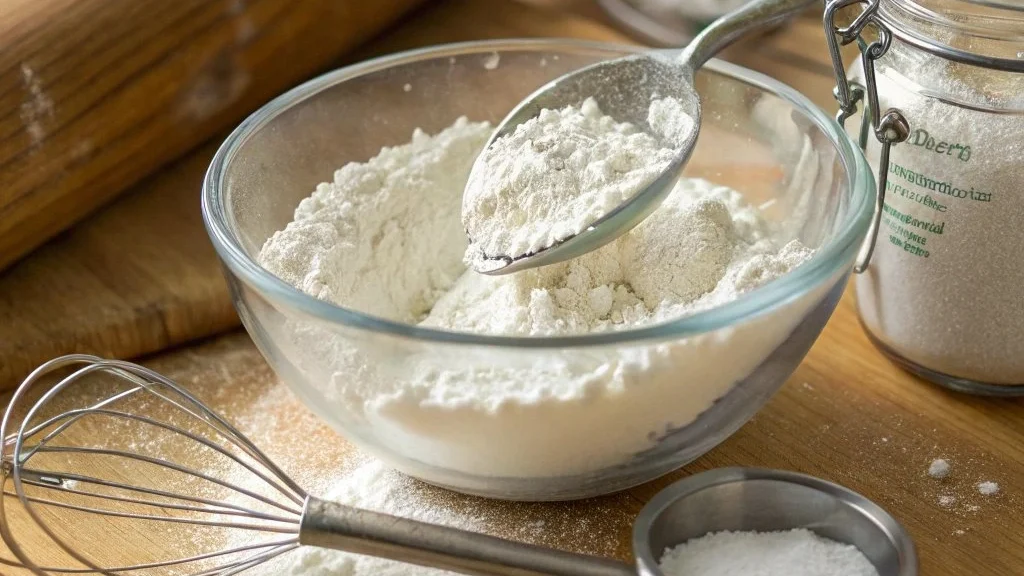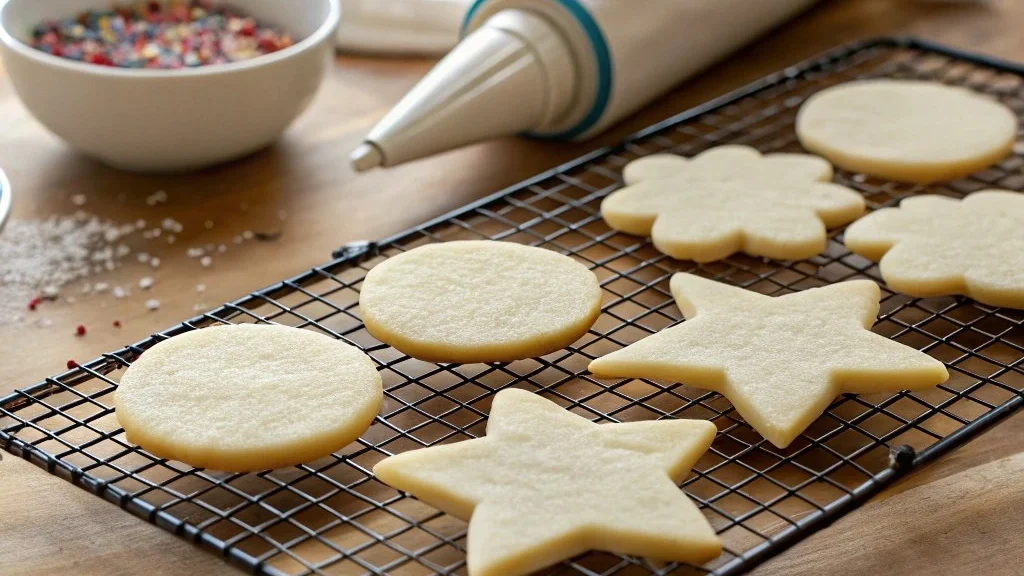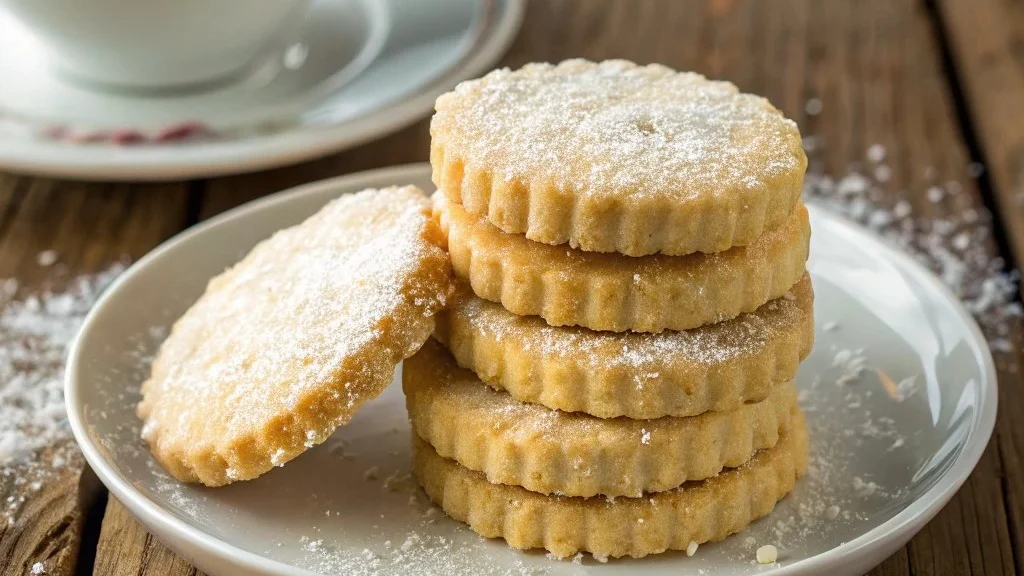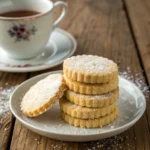Cornstarch is a common ingredient that may not seem like a star player in cookie recipes but has a surprisingly significant impact on the texture, appearance, and overall quality of baked goods. Whether you’re a home baker or a professional, understanding the role of cornstarch in cookies can help you elevate your creations. This article explores the science behind cornstarch in cookies, its effects on texture, and how to use it to enhance your baking.
Table of Contents

How Cornstarch Affects Cookie Dough
Cornstarch plays a key role in shaping the texture, structure, and overall quality of cookie dough. When used in the right proportions, it can transform ordinary cookies into soft, tender, and well-formed treats. Let’s explore how this ingredient enhances baking results.
1. Creating Soft and Tender Cookies
For those who love delicate, melt-in-your-mouth cookies, adding a small amount of starch to the dough makes a noticeable difference.
- Gluten Control: Too much gluten development can make cookies tough. Since cornstarch is naturally gluten-free, it helps prevent excessive gluten formation, ensuring a softer texture.
- Perfect for Light Cookies: Butter cookies, shortbread, and sugar cookies benefit from this ingredient, giving them a fragile yet rich consistency.
2. Improving Thickness and Shape Retention
A major challenge in baking is achieving cookies that hold their shape instead of spreading too thin in the oven.
- Acts as a Stabilizer: By thickening the dough slightly, cornstarch helps cookies maintain a uniform structure.
- Great for Cut-Out Designs: If making decorative cookies, adding this ingredient ensures the details remain crisp and well-defined.
- Works Well with Flour Blends: Many bakers mix a small amount of starch with all-purpose flour to achieve a balance between structure and softness.
3. Achieving a Fine, Crumbly Texture
If you prefer cookies that are light yet rich, incorporating cornstarch into your recipe makes a noticeable difference.
- Smooth Consistency: The fine, powdery nature of this ingredient blends seamlessly, creating a velvety finish.
- Better Moisture Balance: It prevents cookies from feeling too dry while still ensuring a delicate bite.
- Enhances High-Fat Recipes: In recipes like shortbread, it binds with butter to create a uniform, non-greasy dough.
4. Preventing Over-Mixing for a Flawless Dough
Overworking cookie dough can lead to dense, chewy textures. Starch-based ingredients naturally limit elasticity, making the dough easier to handle and preventing excessive mixing.
5. Extending Freshness and Shelf Life
Nobody likes a cookie that turns stale too quickly. Adding a small amount of cornstarch improves moisture retention, helping baked goods stay soft and fresh for several days.
- Locks in Moisture: Prevents cookies from becoming too dry over time.
- Ideal for Batch Baking: If preparing cookies ahead of time, using a starch component ensures they still taste fresh.
Enhancing the Texture and Structure of Cookies
Cornstarch contributes to an exceptionally smooth texture, making cookies lighter and more refined.
- Smoother Mouthfeel: A fine texture gives cookies a luxurious, delicate quality.
- Prevents Toughness: By limiting gluten development, it ensures cookies remain tender and easy to chew.
- Perfect Consistency: Balances firmness and softness, making cookies hold together without crumbling too much.
Controlling Cookie Spread During Baking
One of the most common baking challenges is cookies spreading too much in the oven, leading to thin, flat, and overcooked results. Proper ingredient balance and technique can help prevent this issue.
- Thickens the Dough: Helps absorb excess moisture, reducing excessive spreading.
- Stabilizes the Shape: Slows down butter melting, ensuring cookies hold their form.
- Chewy Center, Crisp Edge: Maintaining thickness preserves the ideal balance between a crisp exterior and a soft interior.
Enhancing the Appearance of Cookies
Beyond flavor and texture, the visual appeal of cookies plays a significant role, especially for decorated varieties.
- Defined Edges: Keeps decorative cookies looking sharp and precise.
- Smooth Surface: Minimizes imperfections, making cookies ideal for icing or frosting.
- Even Browning: Prevents dark, uneven edges while ensuring a beautiful golden finish.
How to Incorporate Cornstarch into Cookie Dough
To get the best results, it’s essential to use proper techniques when adding this ingredient to your cookie dough.
1. Replacing a Portion of Flour
Most recipes suggest substituting 1-2 tablespoons of flour per cup with cornstarch. This simple change helps create a softer, less elastic dough, improving texture.
2. Finding the Right Balance
Using too much starch can make cookies excessively crumbly. Sticking to recommended ratios ensures the perfect structure while maintaining tenderness.
3. Blending Evenly for a Smooth Dough
For the best results, sift cornstarch together with flour before mixing it into the dough. This prevents clumping and ensures a uniform texture throughout the cookies.

Common Cookie Recipes Featuring Cornstarch
Cornstarch is a cornerstone in certain cookie recipes, playing a critical role in defining their texture and shape. Below are examples of popular cookies that benefit from cornstarch:
1. Shortbread Cookies
Shortbread cookies are among the most iconic recipes where cornstarch shines.
- Texture: Cornstarch gives shortbread its signature tender and crumbly texture. This quality makes the cookies dissolve in your mouth.
- Proportions: These cookies often use a significant amount of cornstarch compared to flour, sometimes in a 1:3 ratio.
- Flavor Profile: Since shortbread relies on a buttery flavor, cornstarch enhances the lightness without overshadowing the richness of the butter.
- Pro Tip: Adding cornstarch also prevents the dough from sticking, making it easier to roll out and shape.
2. Snickerdoodles
Cornstarch is a game-changer in snickerdoodle recipes.
- Soft and Pillowy: A touch of cornstarch makes snickerdoodles fluffier and less dense, adding to their appeal as a soft and chewy cookie.
- Consistency: It ensures uniform thickness during baking, so the cookies remain chewy in the center while having slightly crisp edges.
- Flavor Pairing: The neutral nature of cornstarch complements the warm cinnamon-sugar coating, letting the flavors stand out without interference.
3. Sugar Cookies
Cornstarch is crucial for creating sugar cookies that hold their shape perfectly.
- Shape Retention: Sugar cookies are often cut into intricate designs. Cornstarch helps the dough resist spreading or puffing during baking, ensuring clean, sharp edges.
- Texture: It adds a smooth texture to the cookies, making them ideal for icing or decoration.
- Versatility: Cornstarch in sugar cookie recipes allows bakers to achieve the desired balance between a soft center and slightly crisp outer edges.
- Pro Tip: Chilling sugar cookie dough with cornstarch further improves its ability to hold its shape, especially for cut-outs.
By incorporating cornstarch into your cookie recipes, you can elevate classics like shortbread, snickerdoodles, and sugar cookies, transforming them into bakery-quality delights. Whether you’re aiming for tender crumbs, soft textures, or precise shapes, cornstarch offers endless possibilities in cookie baking.
Soft and Tender Sugar Cookies
This recipe uses cornstarch to create sugar cookies that are soft, buttery, and hold their shape perfectly. Ideal for decorating or enjoying plain, these cookies are a hit for any occasion.
Ingredients:
For the Cookies:
- 2 ½ cups all-purpose flour
- 2 tablespoons cornstarch
- 1 teaspoon baking powder
- ½ teaspoon salt
- 1 cup (2 sticks) unsalted butter, softened
- 1 cup granulated sugar
- 1 large egg
- 1 teaspoon pure vanilla extract
- 1 teaspoon almond extract (optional)
For Decoration (Optional):
- Royal icing or buttercream
- Food coloring
- Sprinkles
Instructions:
Prepare the Dry Ingredients
- In a medium bowl, sift together the flour, cornstarch, baking powder, and salt.
- Mix until well combined and set aside.
Cream the Butter and Sugar
- In a large bowl, use a hand or stand mixer to beat the softened butter and sugar together until light and fluffy (about 2-3 minutes).
- Add the egg, vanilla extract, and almond extract (if using) to the butter mixture, beating until fully incorporated.
Combine Wet and Dry Ingredients
- Gradually add the dry ingredients to the wet mixture, mixing on low speed. Stop once the dough is smooth and all ingredients are just combined. Avoid overmixing.
Chill the Dough
- Divide the dough into two equal portions. Flatten each portion into a disk and wrap it in plastic wrap.
- Chill the dough in the refrigerator for at least 1 hour or up to 24 hours. Chilling helps the dough firm up, making it easier to roll and ensuring the cookies maintain their shape during baking.
Roll and Cut the Cookies
- Preheat your oven to 350°F (175°C) and line baking sheets with parchment paper.
- On a lightly floured surface, roll out one portion of chilled dough to about ¼ inch thickness.
- Use cookie cutters to create desired shapes, then transfer the shapes to the prepared baking sheets. Leave about 1 inch of space between each cookie.
Bake the Cookies
- Bake the cookies in the preheated oven for 10-12 minutes, or until the edges are just beginning to turn golden.
- Remove from the oven and let the cookies cool on the baking sheet for 5 minutes before transferring them to a wire rack to cool completely.
Decorate (Optional)
- If desired, decorate the cooled cookies with royal icing, buttercream, or sprinkles.
- Let the decorations set before serving or storing.
Storage:
- Store undecorated cookies in an airtight container at room temperature for up to 5 days.
- Decorated cookies can be stored similarly but are best enjoyed within 3 days for optimal freshness.
Enjoy these soft and tender sugar cookies! Whether plain or decorated, their perfect texture and buttery flavor will make them a favorite treat for all.

FAQ
Can I Substitute Cornstarch for Flour in Cookies?
While it can replace a portion of the flour in a cookie recipe, it cannot entirely replace it. Flour contains gluten, which provides the structure needed for cookies to hold their shape. Cornstarch is often used in combination with flour to create soft, tender textures. For creative baking ideas, explore these unique cookie recipes to delight your taste buds.
Does Cornstarch Affect Flavor?
It is flavorless, so it doesn’t impact the taste of cookies. Its effects are purely textural, helping cookies achieve a softer or lighter consistency. Pairing it with the right ingredients, like those in recipes with cream of tartar, as discussed in what does cream of tartar do in cookies, can enhance your baked goods’ overall texture.
What Happens If I Use Too Much Cornstarch?
Using too much cornstarch can lead to cookies that are too crumbly and may fall apart easily. It’s crucial to follow recipes closely to achieve the right balance of ingredients. If your cookies crumble, check out tips on how to keep crumble cookie good to salvage or prevent the issue.
Can I Use Cornstarch in Gluten-Free Cookies?
Yes! it is a great addition to gluten-free cookie recipes. It helps improve texture and structure by compensating for the absence of gluten. Combined with other gluten-free flours, it can make cookies soft and cohesive. If you enjoy experimenting, try incorporating cornstarch in gluten-free muffins as well, and learn what is the secret to moist muffins for best results.
What Are Some Cornstarch Alternatives for Baking?
It can be replaced with similar thickening agents like arrowroot powder or tapioca flour in most recipes. If the recipe also calls for baking soda, read what can I substitute for 1 teaspoon of baking soda? A complete guide for tips on maintaining consistency in your baked goods.
Conclusion
Cornstarch is a versatile ingredient that can transform cookies by making them softer, thicker, and more visually appealing. Whether you’re crafting delicate shortbread or chewy sugar cookies, incorporating cornstarch into your recipes can elevate your baking game. Experiment with this humble pantry staple and discover the difference it makes in your cookies!

Soft and Tender Sugar Cookies
Ingredients
For the Cookies
- 2.5 cups all-purpose flour
- 2 tablespoons cornstarch
- 1 teaspoon baking powder
- 0.5 teaspoon salt
- 1 cup unsalted butter, softened (2 sticks)
- 1 cup granulated sugar
- 1 large egg
- 1 teaspoon pure vanilla extract
- 1 teaspoon almond extract (optional)
For Decoration (Optional)
- Royal icing or buttercream
- Food coloring
- Sprinkles
Instructions
Preparation
- In a medium bowl, sift together the flour, cornstarch, baking powder, and salt. Mix until well combined and set aside.
- In a large bowl, use a hand or stand mixer to beat the softened butter and sugar together until light and fluffy (about 2-3 minutes).
- Add the egg, vanilla extract, and almond extract (if using) to the butter mixture, beating until fully incorporated.
- Gradually add the dry ingredients to the wet mixture, mixing on low speed. Stop once the dough is smooth and all ingredients are just combined. Avoid overmixing.
- Divide the dough into two equal portions. Flatten each portion into a disk and wrap it in plastic wrap. Chill the dough in the refrigerator for at least 1 hour or up to 24 hours.
Baking
- Preheat your oven to 350°F (175°C) and line baking sheets with parchment paper.
- On a lightly floured surface, roll out one portion of chilled dough to about ¼ inch thickness.
- Use cookie cutters to create desired shapes, then transfer the shapes to the prepared baking sheets, leaving about 1 inch of space between each cookie.
- Bake the cookies in the preheated oven for 10-12 minutes, or until the edges are just beginning to turn golden.
- Remove from the oven and let the cookies cool on the baking sheet for 5 minutes before transferring them to a wire rack to cool completely.
Decorating
- If desired, decorate the cooled cookies with royal icing, buttercream, or sprinkles. Let the decorations set before serving or storing.





